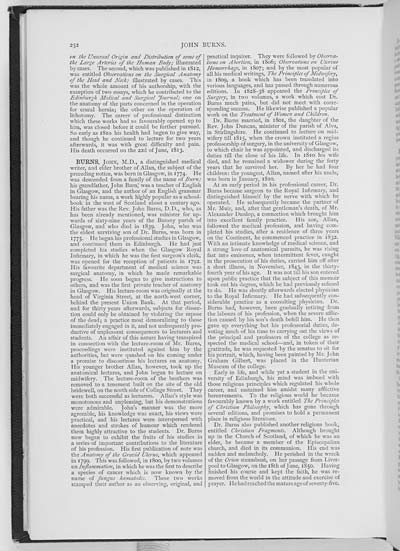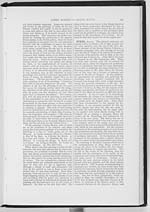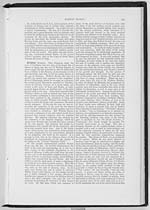252
on the Unusual Origin and Distribution of some of
the Large Arteries of the Human Body; illustrated
by cases. The second, which was published in 1812,
was entitled Observations on the Surgical Anatomy
of the Head and Neck; illustrated by cases. This
was the whole amount of his authorship, with the
exception of two essays, which he contributed to the
Edinburgh Medical and Surgical Journal; one on
the anatomy of the parts concerned in the operation
for crural hernia; the other on the operation of
lithotomy. The career of professional distinction
which these works had so favourably opened up to
him, was closed before it could be further pursued.
So early as 1810 his health had begun to give way,
and though he continued to lecture for two years
afterwards, it was with great difficulty and pain.
His death occurred on the 22d of June, 1813.
BURNS, JOHN, M.D., a distinguished medical
writer, and elder brother of Allan, the subject of the
preceding notice, was born in Glasgow, in 1774. He
was descended from a family of the name of Burn;
his grandfather, John Burn, was a teacher of English
in Glasgow, and the author of an English grammar
bearing his name, a work highly popular as a school-
book in the west of Scotland about a century ago.
His father was the Rev. John Burns, D.D., who, as
has been already mentioned, was minister for up-
wards of sixty-nine years of the Barony parish of
Glasgow, and who died in 1839. John, who was
the eldest surviving son of Dr. Burns, was born in
1775. He began his professional studies in Glasgow,
and continued them in Edinburgh. He had just
completed his studies when the Glasgow Royal
Infirmary, in which he was the first surgeon's clerk,
was opened for the reception of patients in 1792.
His favourite department of medical science was
surgical anatomy, in which he made remarkable
progress. He soon began to give instructions to
others, and was the first private teacher of anatomy
in Glasgow. His lecture-room was originally at the
head of Virginia Street, at the north-west corner,
behind the present Union Bank. At that period,
and for thirty years afterwards, subjects for dissec-
tion could only be obtained by violating the repose
of the dead; a practice most demoralizing to those
immediately engaged in it, and not unfrequently pro-
ductive of unpleasant consequences to lecturers and
students. An affair of this nature having transpired
in connection with the lecture-room of Mr. Burns,
proceedings were instituted against him by the
authorities, but were quashed on his coming under
a promise to discontinue his lectures on anatomy.
His younger brother Allan, however, took up the
anatomical lectures, and John began to lecture on
midwifery. The lecture-room of the brothers was
removed to a tenement built on the site of the old
bridewell, on the north side of College Street. They
were both successful as lecturers. Allan's style was
monotonous and unpleasing, but his demonstrations
were admirable. John's manner was the more
agreeable, his knowledge was exact, his views were
practical, and his lectures were interspersed with
anecdotes and strokes of humour which rendered
them highly attractive to the students. Dr. Burns
now began to exhibit the fruits of his studies in
a series of important contributions to the literature
of his profession. His first publication of note was
the Anatomy of the Gravid Uterus, which appeared
in 1799. This was followed, in 1800, by two volumes
on Inflammation, in which he was the first to describe
a species of cancer which is now known by the
name of fungus h�matodes. These two works
stamped their author as an observing, original, and
practical inquirer. They were followed by Observa-
tions on Abortion, in 1806; Observations on Uterine
H�emorrhage, in 1807; and by the most popular of
all his medical writings, The Principles of Midwifery,
in 1809, a book which has been translated into
various languages, and has passed through numerous
editions. In 1828-38 appeared the Principles of
Surgery, in two volumes, a work which cost Dr.
Burns much pains, but did not meet with corre-
sponding success. He likewise published a popular
work on the Treatment of Women and Children.
Dr. Burns married, in 1801, the daughter of the
Rev. John Duncan, minister of the parish of Alva,
in Stirlingshire. He continued to lecture on mid-
wifery till 1815, when the crown instituted a regius
professorship of surgery, in the university of Glasgow,
to which chair he was appointed, and discharged its
duties till the close of his life. In 1810 his wife
died, and he remained a widower during the forty
years that he survived her. By her he had four
children: the youngest, Allan, named after his uncle,
was born in January, 1810.
At an early period in his professional career, Dr.
Burns became surgeon to the Royal Infirmary, and
distinguished himself by the nerve with which he
operated. He subsequently became the partner of
Mr. Muir, and, after that gentleman's death, of Mr.
Alexander Dunlop, a connection which brought him
into excellent family practice. His son, Allan,
followed the medical profession, and having com-
pleted his studies, after a residence of three years
on the Continent, he commenced practice in 1832.
With an intimate knowledge of medical science, and
a strong love of anatomical pursuits, he was rising
fast into eminence, when intermittent fever, caught
in the prosecution of his duties, carried him off after
a short illness, in November, 1843, in the thirty-
fourth year of his age. It was not till his son entered
upon public practice that the subject of this memoir
took out his degree, which he had previously refused
to do. He was shortly afterwards elected physician
to the Royal Infirmary. He had subsequently con-
siderable practice as a consulting physician. Dr.
Burns had, however, been gradually retiring from
the labours of his profession, when the severe afflic-
tion caused by his son's death befell him. He then
gave up everything but his professorial duties, de-
voting much of his time to carrying out the views of
the principal and professors of the college as re-
spected the medical school�and, in token of their
gratitude, he was requested by the senatus to sit for
his portrait, which, having been painted by Mr. John
Graham Gilbert, was placed in the Hunterian
Museum of the college.
Early in life, and while yet a student in the uni-
versity of Edinburgh, his mind was imbued with
those religious principles which regulated his whole
career, and sustained him amidst many afflictive
bereavements. To the religious world he became
favourably known by a work entitled The Principles
of Christian Philosophy, which has gone through
several editions, and promises to hold a permanent
place in religious literature.
Dr. Burns also published another religious book,
entitled Christian Fragments. Although brought
up in the Church of Scotland, of which he was an
elder, he became a member of the Episcopalian
church, and died in its communion. His end was
sudden and melancholy. He perished in the wreck
of the Orion steamboat, on her passage from Liver-
pool to Glasgow, on the 18th of June, 1850. Having
finished his course and kept the faith, he was re-
moved from the world in the attitude and exercise of
prayer. He had reached the mature age of seventy-five.�

![]() Universal Viewer |
Universal Viewer | ![]() Mirador |
Large image | Transcription
Mirador |
Large image | Transcription
![]()

